How to provide employee development without promotions
Mary Meeker’s Internet Trends 2015 found it was the top work benefit valued by Millennials:
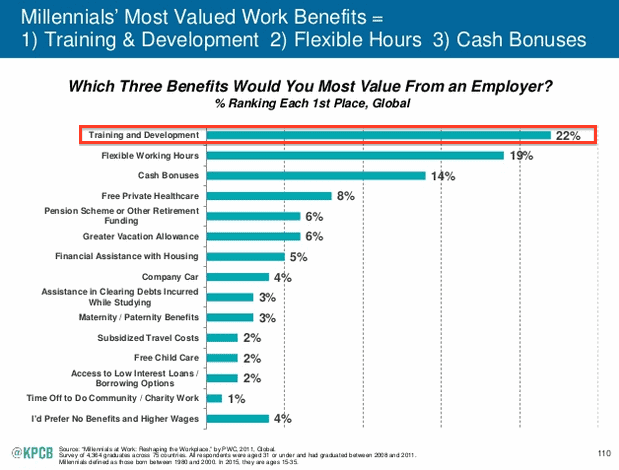
Deloitte’s 2016 study of Millennials also found growth and development were top reasons to join a company:
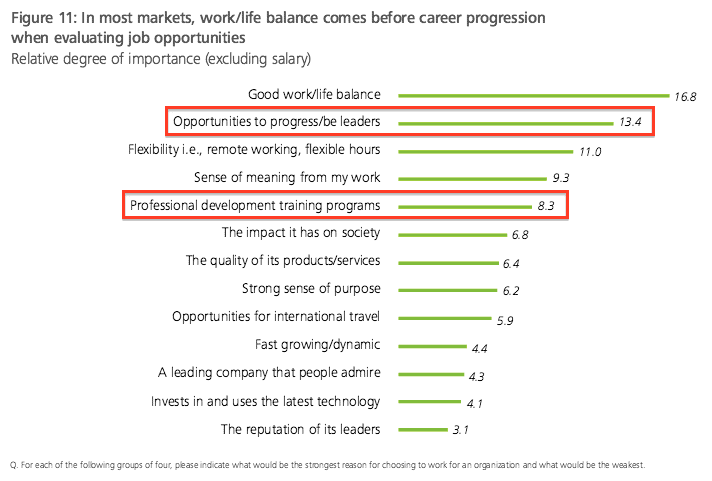
And in books, Reid Hoffman, cofounder of the massive career site, Linkedin, wrote in his book, The Alliance, of the urgency to invest in employee development for everyone:
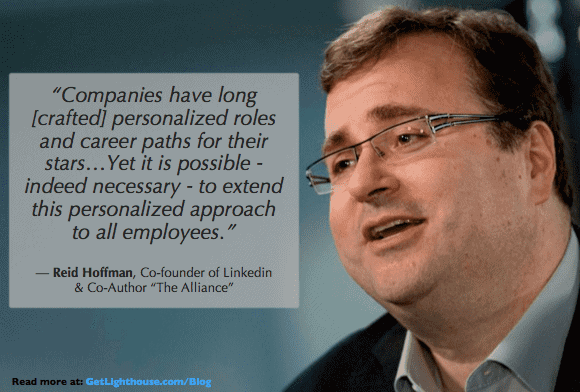
Got Growth?
Despite all this evidence and encouragement, employee development rarely seems to be happening.
As Julie Winkle Giulioni wrote recently for SmartBriefs, a combination of misconceptions, poor planning, and lack of creativity has prevented the growth that employees crave from happening for most people.
As a manager, what do you do?
Like it or not, your team will be a turnover risk if they’re not growing.
Doing the same thing for multiple years can get old, as can too much boring, repetitive work. Your people are one recruiter email, one catch-up with a friend, or well-timed job posting from looking elsewhere.
Challenges and new opportunities capture the imagination and excite people. They can either find those on the job with you, or they’ll eventually look elsewhere.
If only it were that easy…
Unfortunately, the most obvious and easy development opportunity (promotion) is often unavailable. Many of the reasons are beyond the control of you as a manager:
- Isolated Roles: Depending on the specialization, location, and skills required for a role, it can limit the options for advancement. This can be especially true for those working in support, or remotely.
- Hiring & Wage Freezes: If your company isn’t growing, or is hurting financially, you may not have budget or growth opportunities readily available.
- Narrowing Hierarchies: It’s a simple numbers game; org charts narrow to the top like a pyramid. Even as your own team grows, only 1 or 2 out of every 10 people can become a manager.
- Gray Ceiling: As people work longer before retiring, it can block younger people from advancing. This backup can clog the org chart multiple layers down if it is widespread.
- Fluid Organization: Whether you work in a flat organization, holocracy, or a company growing so rapidly, there’s no defined org chart, a path for promotion may not be clear.
Make lemonade
It would be easy to throw up your hands and give up in any of the above situations, but that would be a shame for you and your team. You can do better.
Remember what Andy Grove, legendary founder and CEO of Intel, says about being a manager:
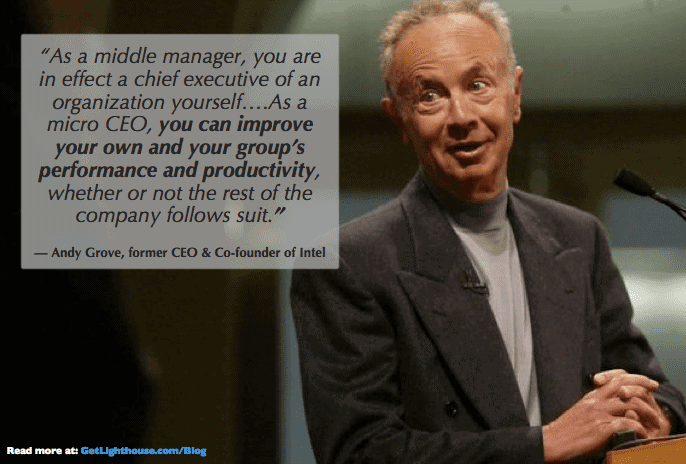
Just because you can’t promote anyone right now does not mean you can’t develop your employees, providing the growth they crave.
Here’s a few ideas that you can apply to anyone on your team, no matter what’s going on in the rest of your company.
How to Grow Your Employees When You Can’t Promote Them
There are many ways to grow people that does not require a promotion or financial bonus. Any of the ideas below can help you tap into powerful intrinsic motivation that can boost morale and motivate your team members.
1) Consider lateral moves
Moving up in your organization is not the only way people can grow. A change in responsibility or role can be just as refreshing and motivating.
When someone on your team starts to look restless or bored in their current role, talk to them about what parts of the business are interesting to them. Look for signs of areas they want to learn more about to find opportunities for lateral moves.
Brian Halligan, CEO of HubSpot, is a big fan of this approach. He discusses it in a great TEDx talk below on “Inbound HR” that reflects on managing Millennials: (lateral moves are discussed starting at the 8:05 mark)
“Every quarter we measure how many employees got a new job within the company in the last quarter… if they’re not moving around enough, not learning enough, eventually we’re going to start losing some of these smart people.”
Look around your team and think about how you may be able to mix up everyone’s responsibilities. Two team members who have been doing the same thing for a couple years may both be more excited to do the other person’s job. It also help foster teamwork, as they can train each other.
Good people adapt
A common fear that some managers have is that a person won’t succeed in a new role they aren’t familiar with. That’s a mistaken, fixed mindset.
If they’re motivated, and you help them understand the skills they need to develop, that won’t be a problem.
If you want your team to be successful and grow, then you should demonstrate and reward the growth mindset. As coined by Stanford psychologist Carol Dweck, the growth mindset embraces opportunities for learning new skills and growing beyond what you can already do today. This chart captures the key differences:
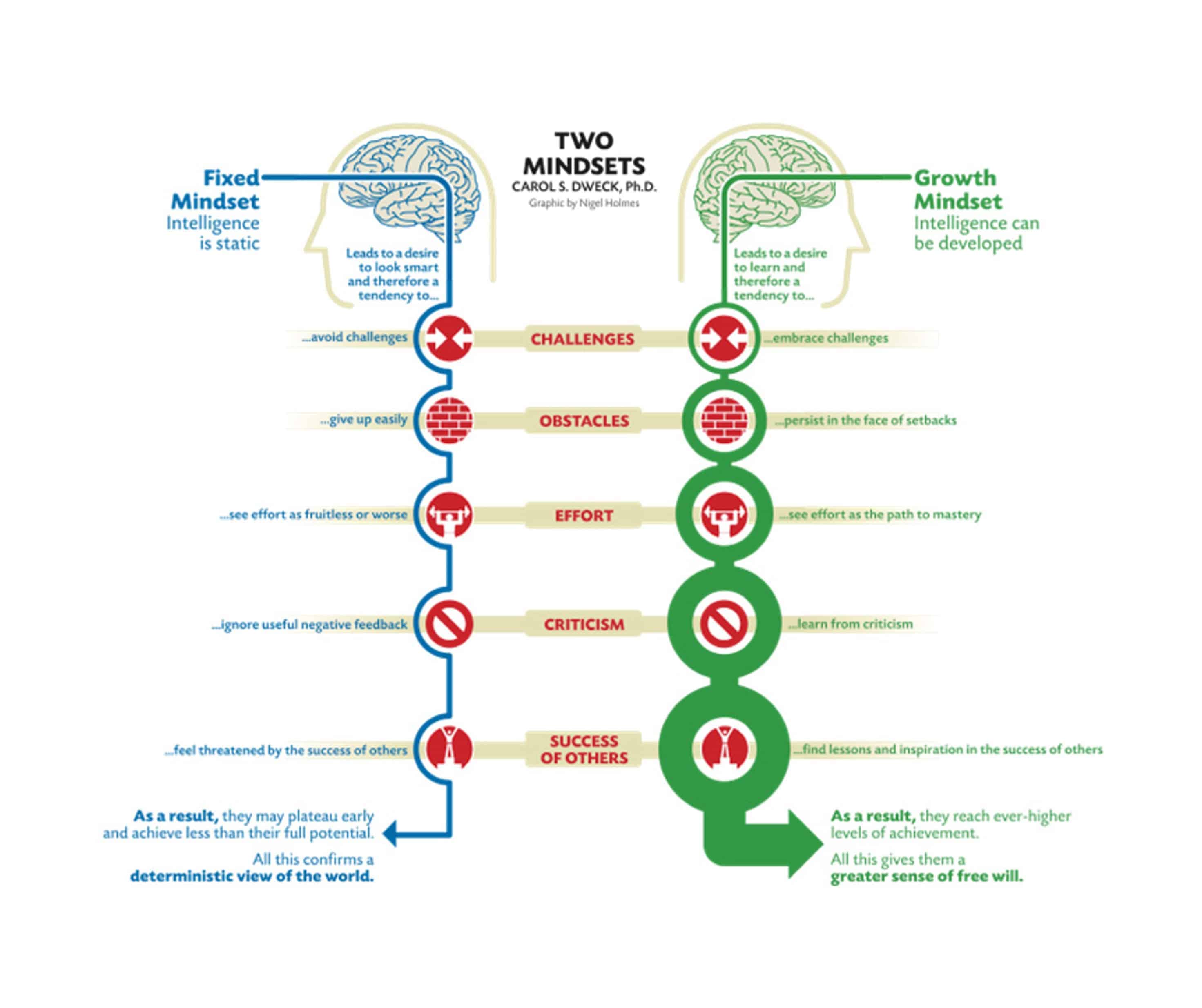
By embracing the growth mindset, you can ensure your people always consider paths to new development opportunities and take on new challenges with confidence.
A story: A lateral leap
Last year, I was speaking to a friend. His best engineer told him one day he was tired of coding. He wanted to try his hand at marketing and was planning to look for a job elsewhere if it wasn’t an option there.
As it turned out, my friend was looking to hire a marketer, so rather than simply lose his best engineer and gain nothing, he gave the marketing job to the engineer.
Months later, this former engineer has become an incredible asset to the marketing team. He poured the same energy he once used to become a great engineer into learning all about marketing. His old skills also helped the marketing team move faster; they don’t have to lobby for engineering time anymore. Meanwhile, my friend avoided losing a beloved team member. Everyone won.
If you can’t promote someone, or they’re not interested in those roles, look for ways they can move laterally. It’s a great way to keep things fresh, present new challenges, and provide new learning opportunities.
2) Focus on skills growth
Can’t promote someone right now? No problem. Focus on improving their skills.
Take a hard look at each of your team member’s skills and work with them on ones they can improve. If you can tie it to a future opportunity they’re interested in, or an area they’re passionate about, all the better.
Focusing on a specific piece of someone’s work and improving it significantly can boost your team member’s motivation. It can bring fresh eyes to a task they may have gotten a little too routine in how they handle it, and bring out their creativity as they work on it.
Bonus: A perfect opportunity for feedback
Doing this also taps into the common desire for feedback. Most employees, and especially Millennials, want more feedback than they’re receiving as a recent study revealed:
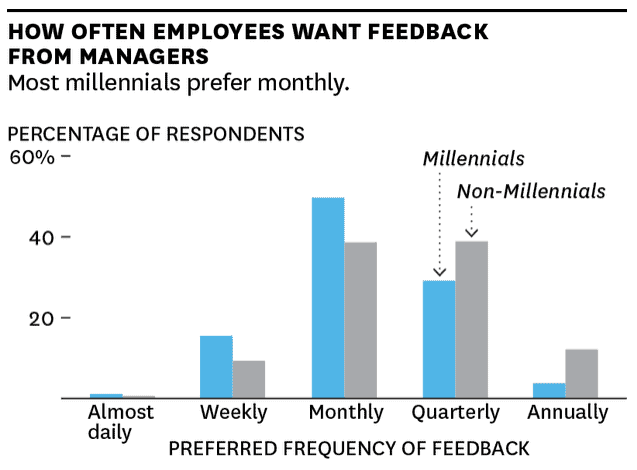
Leverage your one on ones
Your one on ones are the perfect time to work with them on skills growth. You can first use a meeting to talk about areas you think they can improve and what they’re interested in. Then, subsequent one on ones can include checking in on them, and giving feedback on how they’re doing.
Conveniently, the frequency of your one on ones should fit nicely with what the chart above shows is the rate of feedback employees would like.
Using your one on ones to develop skills creates a virtuous cycle that ensures they feel progress on their growth and development. It taps into a key motivator for team members that psychology researcher Teresa Amabile discovered. Put simply:
“Of all the things that can boost emotions, motivation, and perceptions during a workday, the single most important is making progress in meaningful work.”
Improving existing skills and developing valuable new ones that advance their career definitely fits into the category of “meaningful work.”
Building skills doesn’t have to break the bank.
Beyond your own feedback, there are a variety of ways you can help people develop their skills.
One of my favorites is to buy team members books on subjects they are interested in learning about. As marketer, author, and well known speaker, Seth Godin has said:

Buying a book for a team member to build their skills is one of the highest impact and least expensive ways to support their growth. If you’re not sure what book to get them, ask an expert so you pick one worth their effort to read.
Other ways you can help people grow that costs you little to no time or money include:
- Introduce them to a mentor: Someone further along in a similar career can provide excellent guidance and advice for them.
- Connect them to peers: As a manager, you often know more people in the company than they do. Connect them with someone already skilled in an area of their interest can have a big impact.
- Send them to a meetup or conference: Keep an eye out for events they can go to that they can learn from. If you don’t have a big budget for this, look for cheaper, local ones, or help them speak as an expert on something to get a free pass.
A story: an unexpected change.
In a past business I was running, I had a team member tell me one day she wanted to become a product manager. She was currently doing business development, so this came as a big surprise.
Making matters worse, we didn’t really have an opening for product, and her current role was really important to us.
Seeing her passion, I agreed to help her learn about product management as long as she continued to do good work for us in business development. Over the next year, I helped her learn those skills by doing the following:
- Mentoring: Once a month we met and talked about anything she wanted to about product management based on my own experience as one.
- Books: I bought her the best books I had read on product management. Each time she finished one, we’d discuss key takeaways and what the next book should be.
- Introductions: Knowing there’s multiple approaches to product management, I introduced her to friends who were good product managers in different ways than I was.
Not only did these help her learn the skills she needed for the role, it motivated her in ways I never expected. During this period, she did her best work ever in business development.
As it turns out, investing in your people’s growth, even in brief, inexpensive ways, pays you back tenfold as they work hard for you each day in return.
3) Tap into their passion
As your company and team grows, there are small habits and processes that can become clunky. Maybe it was the best you could do initially, or a hack because you were just trying to move fast. The longer you work, the more of these challenges there are.
When you’re looking for ways to develop your employees, an underrated approach is to look at these problems.
The next time you hear someone complain about a broken process or inefficient system, see if they’d be willing to take it on as a project. This can be a huge win-win:
- Channel their passion: If they’re fired up enough to complain about it, they are probably also motivated to do something about it.
- Enhance their resume: If they’re successful in improving the system, you should be able to measure the results. This can become an awesome story for a future interview, and great bullet point on a resume.
- Relieve stress: When it’s something that drives them crazy every day, finally getting to fix it can be a big stress relief for them. Anyone else affected will also be happy to see the change or improvement.

From Trash to Treasure
As the saying goes, “one man’s trash is another man’s treasure.” You may be surprised what someone on your team could be motivated to work on that others would hate. Tap into that, and not only do you get much needed work done, but others on the team are likely to appreciate something they dreaded.
Here’s a few examples to spark ideas regardless of the department you’re in:
- Design: Start or update your style guide, design on brand 404 pages, identify design quick wins for engineering.
- Engineering: Clean up old code, help build out new best practices, improve the process of onboarding new engineers.
- Sales: Improve training guides, formalize an upsell process, create a cheat sheet for beating various competitors.
- Marketing: Organize and improve your analytics reporting, start a program to interview influencers in your industry.
- Support/Success: Summarize support issues to help product & leadership understand needs, create new support templates, improve hand off processes for various issues or teams.
Intrinsic motivation at its best
What’s particularly awesome about this approach is how tightly it taps into intrinsic motivation. As Dan Pink shares in his TED talk, there are 3 keys to motivating employees intrinsically:
“Autonomy: the urge to direct our own lives.
Mastery: the desire to get better and better at something that matters.
Purpose: the yearning to do what we do in the service of something larger than ourselves.”
By focusing their growth on a project they’re passionate about, you hit all 3 of those areas:
Autonomy: they are driving and leading this project to goals you agree on.
Mastery: they’re building key skills by taking on the project.
Purpose: the project helps them, their team, and the company in a measurable way.
Tap into areas of work your team members are fired up about and you may be surprised by the results. Not only can you help them grow, but the work can improve things for everyone on your team or even across your company.
—
Constraints breed creativity. Don’t let a lack of opportunities for promotion stop you from investing in employee development for everyone on your team. Doing so will help you not only continue their growth and learning, but also boost their morale and motivation.
What are your favorite ways to invest in the growth of your people?
